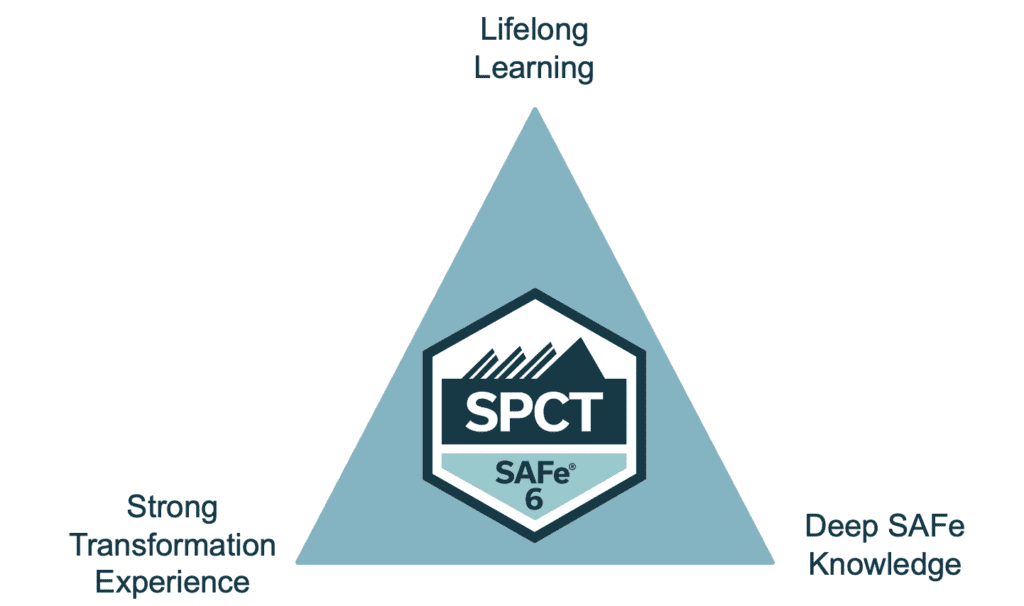
“I am so glad I did it. It is unreservedly the single most important thing I have done in my career. If you are a seasoned professional with a commitment to lifelong learning and are wondering what your next career move might be, I highly recommend you take a look at the SPCT program.”
—Michael Casey, SPCT, Agile Big Picture
As more organizations engage with SAFe®, it’s even more critical that we have knowledgeable, experienced SAFe leaders to help transform large enterprises and continue to shape the way SAFe is being implemented. If you have deep SAFe knowledge, are a lifelong learner, are SAFe Practice Consultant (SPC)-certified, and excel in training and coaching, I invite you to consider becoming a SAFe Practice Consultant-T (SPCT).
“As is the case with any certification, you should carefully evaluate SAFe instructors and consultants, and make sure that they have demonstrated experience that is relevant to the role you are asking them to take on. Do not rely on certifications alone as a measure of the skills of a consultant or prospective employee. A notable exception to this is the SAFe Program Consultant Trainer (SPCT) certification [now SAFe® Practice Consultant-T], which does require demonstrated experience with Agile, software development or product management, training and consulting. If you’re hiring someone who has [an] SPCT certification, you can be confident that they do have experience in these areas, as well as experience with SAFe implementation at multiple organizations. However, SPCTs are in short supply. As of February 2020, there are fewer than 100 people worldwide holding this certification.”
— Gartner, “A Technical Professional’s Guide to Successful Adoption of the Scaled Agile Framework (SAFe),” Kevin Matheny, Bill Holz, 13 April 2020
SPCTs are among the most highly regarded SAFe experts in the world. They are also the most sought-after SAFe Trainers, SAFe Trusted Advisors, and SAFe Transformation Architects among enterprises seeking to improve their methods of working and pursue business agility.
As transformation catalysts, SPCTs share their vast industry expertise and skills through teaching, coaching, and handling the most challenging SAFe implementations. And they are experts at communicating, consulting, and creating SAFe knowledge.

SPCT is the most advanced certification you can achieve with SAFe and can be career-changing through job advancement and new opportunities.
SPCT credentials bring the highest level of credibility, which opens doors for you and generates confidence within the organization that you’re helping to create the highest-quality SAFe implementation.
That said, you should know that our selection process has very high standards, and not everyone will get in. To be accepted into the program, you must not only meet the skills and experience prerequisites but have presence and gravitas. The requirements and expectations are slightly different for partners and enterprise employees.
Nominees must either be sponsored by a Gold Partner or an enterprise customer with a SAFe® Enterprise Subscription. However, both must be full-time employees of their respective organizations and are expected to have several years of experience in the tech industry, with five years of Lean-Agile experience and five years of software/systems/product experience.
Here’s how the process works:
- Get nominated: If you or someone you know would make a good candidate, request access to the SPCT portal by sending an email to spct@scaledagile.com. Through the portal, you can submit your documented accomplishments as you achieve them.
- Have an interview: After your nomination requirements have been reviewed and accepted, you’ll have two screening interviews with SPCT guides. Our team will then determine whether you’d be a good fit for the program.
- Attend Immersion Week: If you’re accepted, you’ll be invited to attend SPCT Immersion Week (currently, we hold three to four classes per year) where nominees showcase their knowledge, skills, and abilities in training and consulting with SAFe. You’ll also learn how to teach an Implementing SAFe® class and may even work on a class project that contributes to SAFe’s intellectual property.
- Complete field experience: After Immersion Week, you’ll need to complete additional certification requirements that include teaching SAFe classes, completing SAFe implementations, and finishing the required readings.
- Co-teach an Implementing SAFe® class: Lastly, you’ll participate in a pairing test by co-teaching an Implementing SAFe® class with one of our guides. During this class, we’ll evaluate your presentation, training, and coaching skills.
I believe becoming an SPCT is a valuable and rewarding career goal to aspire to—but I’m not the only one. Here’s what some of our SPCTs have to say:
“SPCTs are differentiated in the marketplace. The SPCT certification is rare and the knowledge and expertise it represents is valuable and much in demand.”
—Simon Chesney, iSPCT, Western Digital Corporation
“Becoming an SPCT takes hard work, but it will pay you back many times over what you put into it in personal growth and career advancement. Get on board the SPCT program and you won’t look back!”
—Michael Casey, SPCT, Agile Big Picture
I encourage you to explore what it takes to become an SPCT to see if this would be a good fit for you or someone you know.
Learn more by contacting spct@scaledagile.com.
About Adam Mattis

Adam Mattis is a SAFe® Fellow and SAFe® Practice Consultant-Trainer (SPCT) at Scaled Agile with many years of experience overseeing SAFe implementations across various industries. He’s also an experienced transformation architect, engaging speaker, energetic trainer, and a regular contributor to the broader Lean-Agile and educational communities. Learn more about Adam at adammattis.com.
Share:
Back to: All Blog Posts
Next: Scrum Master Stories: Resolving Conflict